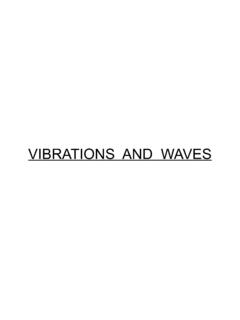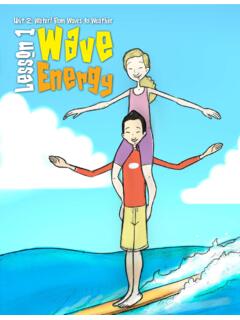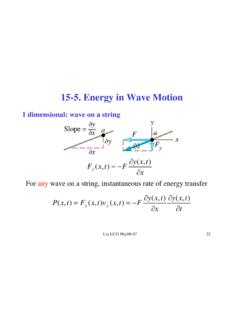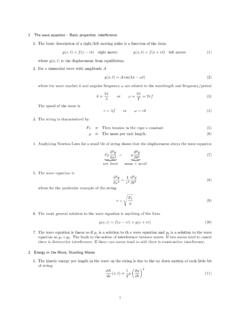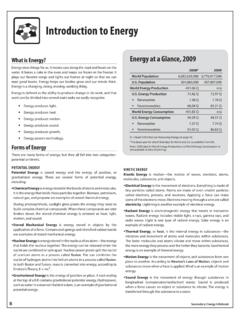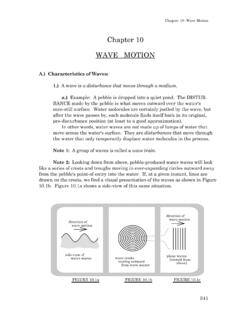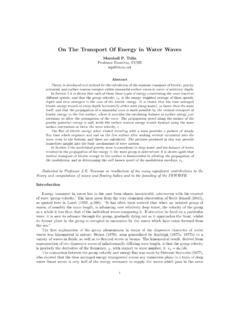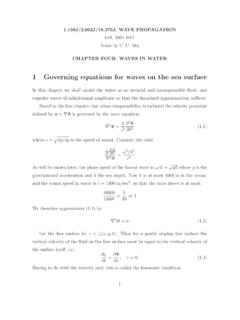Transcription of Chapter 12 Waves - University of Oklahoma
1 Chapter 12 WavesWave MotionFalling dominoes are a good example of Waves . energy is transported from one place to another, but matter is can travel in:1 dimension: (dominoes, string, laser)2 dimensions: (water)3 dimensions: (sound, light bulb)Types of WavesLongitudinal: The elements of the wave are in the same direction as the motion of the : The elements of the wave are in a perpendicular direction to the motion of the compressed slinky, sound string, light wavesConsider a pulse traveling to the rightt0t1y= f(x vt)As tincreases the value of ythat was at a lower x, is now at a higher a wave traveling to the left: y= f(x+ vt) y= x vtAt t= 0, three points on the pulse are (1,1), (2,2), (3,3)At a later time when vt= 1, these points become (1,0), (2,1), (3,2)A wave pulse is moving as illustrated, with uniform speed valong a rope. Which of the graphs below correctly shows the relation between the displacement sof point Pand time (A)(B)(C)(D)Interactive QuestionDescription of Periodic WavesWhether the wave is transverse or longitudinal, we usually draw it as a longitudinal wave to illustrate its : Amplitude : Wavelengthv: Wave velocity, or speed of the waveT: Period, or time it takes one wavelength to passf: Frequency, or number of Waves to pass per time, (1/T) v : Velocity of element on the wave vv= fMass density of string: =dm/dLVelocity of pulse moving to the right:vVelocity of a point on the string moving up.
2 V Wave speed for a stretched stringvtv tIn a time t, the wave moves to the right a distance vt, and up a distance v string has a tension pulling on it of FT, and a force of Fycausing it to move (We are assuming that v t << vt)Fy/FT= v /vvtv tFTFyThese forces cause the string that is initially stationary to at= FTt/m= FTt/( vt)v = a t= Fyt/mFrom the first equation,Fy= mv /t= vtv /t= vv Combining these two equations gives vv /FT= v /v TFv=t= v m/Fy= vm/FTA mass mis hanging on the end of a pulley as shown. If the mass is doubled to 2m, what happens to the frequency of the wave produced when the string is plucked?mA) The frequency is increased by 4B) The frequency is increased by 2C) The frequency is increased by 2D) The frequency is not changedE) The frequency is deceased by 1/2 Interactive QuestionA weight is hung over a pulley as shown. The string is composed of two parts, each made of the same material.
3 Part 1 has four times the diameter as part 2. What is the ratio of the velocity of the wave in part 1 (v1) to that in part 2 (v2)?mv1v2A) 4B) 2C) 1D) 1/2E) 1/4 Interactive QuestionProblem:A string has a mass of kg and a length of m and is set up as shown in the picture. What is the speed of a pulse on this string? 2 kg5 m1 mMathematical Description of WavesConsider a string in the shape of a x 2 1 Fy= mayFTsin 2 FTsin 1= ( x) 2y/ t2If the angles are small, sin = tan = swhere sis the slopeFT(s2 s1)= ( x) 2y/ t2FT( s/ x) = 2y/ t2FT( s/ x) = 2y/ t2As xgets very small, s/ x= s/ x= ( y/ x)/ x= 2y/ x2 2y/ x2= ( /FT) 2y/ t2 2y/ x2= (1/v2) 2y/ t2 Although we derived this for a string, this is a general equation that is true for all one dimensional Waves . The solution to this equation is:y= Asin(kx t)The solution can also be written to emphasize its periodicity:y= Asin{2 (x/ t/T)}or emphasize it is a function x vt: y= Asin{k(x vt)} 2y/ x2= (1/v2) 2y/ t2 Ak2sin(kx t) = A( 2/v2)sin(kx t) v= /kThis function must repeat itself every wavelengthk = 2 k= 2 / kis the wave number This function must repeat itself every period T= 2 = 2 /T = 2 f is angular frequencyv= /k = fInteractive Question(A)(B)(C)(D)(E)A wave traveling to the right on a stretched string is shown below.
4 The direction of the instantaneous velocity of the point P on the string is:+vPNoneSinusoidal Waves travel on five identical strings. Four of the strings have the same tension, but the fifth has a different tension. Use the mathematical forms of the Waves , given below, to identify the string with the different QuestionA)y= (2 cm)sin(2x 4t)B) y= (2 cm)sin(4x 10t)C) y= (2 cm)sin(6x 12t)D) y= (2 cm)sin(8x 16t)E) y= (4 cm)sin(8x 16t)Problem:Transverse Waves on a string have a wave speed of m/s, amplitude of m and a wavelength of m. The Waves travel in the xdirection, and at t= 0, the x= 0 and of the string has zero displacement and is moving in the +ydirection. (a) Write a wave function for this wave. (b)What is the period of the simple harmonic motion for a particle on the string? (c) What is the transverse displacement of a particle at x= m at t= s?
5 (d)At what time after t= s will this point have zero displacement? energy and Power of a WaveConsider a string with a wave propagating down it. Each little section of the string is oscillating in a transverse direction to the wave with simple harmonic motion at an instantaneous velocity of v . We can see this from the wave equation at a fixed value of Dsin(kx t)The kinetic energy of a small part of the string with mass dmisdEkin= (1/2)dm v 2= (1/2)dm ( y/ t)2= (1/2)dm ( D)2cos2(kx t)= (1/2)( dx)( D)2cos2(kx t)+xThe power in a wave is given by: P = dE /dt= (1/2)( dx/dt) 2D2= (1/2) v 2D2 The string oscillates up and down with SHM, so it also has an elastic potential energy :Eel(max) = (1/2)kD2= (1/2)m 2D2 dEel = (1/2)dEel(max)= (1/4)( dx) 2D2 The average kinetic energy is then dEkin = (1/2)( dx)( D)2 cos2(kx t) = (1/4)( dx) 2D2 dE = dEkin + dEel = (1/2)( dx) 2D2In 3-dimension, dm= dV= A dx= Av dt E = (1/2) Avt 2D2 P = (1/2) Av 2D2I = P/A= (1/2) v 2D2 The intensity is the power per area:So substitute Av dtfor dxand integrate to get:Sound WavesSound Waves are created from a source which is vibrating.
6 The vibrating source creates longitudinal Waves in some medium which can be detected by our ear or by an instrument. Sound Waves are longitudinal pressure Waves . The particles in the medium that the sound propagates in will oscillate back and forth longitudinally due to a difference in a piston, moving at speed v, pushing on a tube filled with air. The wave in the air will move at a speed of v . We look at a small section of the air as the piston pushesP+ PPThe impulse given to the section of air is: Ft = p{(P + P)A PA}t= mv PAt= mv = Vv = A xv = Avt v P= vv x= vtA Bv= P= vv P(V/ V) = vv (V/ V) P(V/ V) = vv (Avt/( Av t)) = v2B= v2 This works well for liquids, but for a gas, the velocity is given by:MRTv =where R= J/(mol K) is the universal gas constant, Tis the temperature in Kelvin, Mis the molar mass (kg/mol), and is a constant that depends on the kind of gas.
7 For a diatomic gas it is :How fast does sound travel in air (at 20 C), and in water?A guitar string is plucked and set into vibration. It disturbs the surrounding air, resulting in a sound wave. Which entry in the table below is correct?in stringin airA) the wave is transverseyesyesB) frequency changes if stringyesnois tightenedC) wave is transmitted bynoyesparticle vibrationsD) wave speed increases ifno yestemperature risesE) wave transports energyyesnoInteractive QuestionPitchHigh frequencies create high pitches and low frequencies produce low pitches. Audible: 20 Hz 20,000 Hz Ultrasonic: Above 20,000 HzInfrasonic: Below 20 HzIntensityThe intensity of the sound wave is a measure of how loud it is. The intensity is given by the power per unit area:I P/AThe power is proportional the the square of the wave amplitude. The intensity must increase by about a factor of 10 for a sound to appear twice as loud to a human ear.
8 Therefore, intensity is measured on a log scale using the units of bels or one tenth of a bel, a decibel ( ). A decibel measures the sound intensity levelor decibel level, rather than the intensity. (W/m2) = 10 log(I/I0)I0= 10 12W/m2(I0is approximately the softest audible sound.)Problem:What is the intensity level of a sound wave having an intensity of (a) 10 12W/m2, (b) 10 11W/m2(c) 10 10W/m2 Problem: A sound is measured to have a decibel level of 30 db. If the intensity is decreased by a factor of 2, by how much does the intensity level change?Which of the following is most closely identified with the loudness of a musical note?A) FrequencyB) VelocityC) PhaseD) AmplitudeInteractive QuestionLongitudinal Pressure WavesFor a longitudinal wave, the wave equation is:D= xmsin(kx t) P = B V/V= BA D/A xor in the limit as x 0 P = B D/ x P = Bk xmcos(kx t) = v2 k xmcos(kx t) = v( /k) kxmcos(kx t) = = v xmcos(kx t)A sound wave can be thought of as a longitudinal displacement or a longitudinal pressure wave.
9 Most sound Waves travel out in all three directions from a source. The intensity is equal to the Power/Area. The total power stays the same as the sound spreads over an increasingly large spherical area given by 4 r2 SourceProblem:During a fireworks show a rocket explodes. To a listener who is 640 m away, the sound has an intensity of W/m2. What is the intensity for a listener who is 160 m away?Three observers, A, B, and C are listening to a moving source of sound. The diagram shows the location of the wavecrestsof the moving source with respect to the three observers. Which of the following is true?A) The wavefronts move faster at A than at B and ) The wavefronts move faster at C than at A and ) The frequency of the sound is highest at ) The frequency of the sound is highest at ) The frequency of the sound is highest at QuestionDoppler EffectStationary Source MovingSource vsT = vsT= vs /v = (1 vs/v)f = f/(1 vs/v) = fv/(v vs)If the source is moving away: f = fv/(v+vs)In a similar derivation, for the observer moving:f = f(v+vo)/vfor the observer moving toward the sourcef = f(v vo)/vfor the observer moving away from source = sovvvvffmThe top signs apply when the source and/or object move toward each other and the bottom signs apply when they move away from each : apparent frequencyf:original frequencyvo: velocity of the observer vs: velocity of the sourceAll these equations can be written in a single equation.
10 You are riding on a Ferris wheel and hear a loud whistle being blown from in front of you. On which point on the Ferris wheel will the pitch of the whistle sound lowest?A) AB) BC) CD) DE) Both B and DDirection of MotionABCDW histleInteractive QuestionProblem:An ambulance travels down a highway at a speed of mi/h ( m/s) with its siren emitting a sound with a frequency of 400 Hz. What frequency is heard (a) by someone standing still when the ambulance approaches? (b)by a passenger in a car traveling at 55 mi/h ( m/s) in the opposite direction as it approaches the ambulance? (c) by a passenger in a car traveling at 55 mi/h in the opposite direction as it moves away from the ambulance? Problem:A man sitting in his car which is stopped sounds his horn that has a frequency of 500 Hz. The sound is reflected off of a car moving at 24 m/s toward the man.



